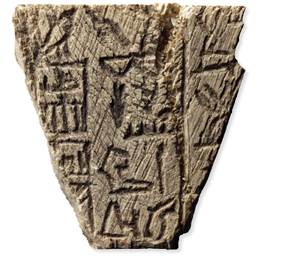The origins of writing
An Oriental Institute Museum exhibit shows how four distinct writing systems emerged independently.
By Ruth E. Kott, AM’07
Photography courtesy the Oriental Institute
In 1952 University of Chicago Assyriologist Ignace Jay Gelb, considered the first scholar to scientifically analyze writing systems, published his seminal work A Study of Writing. At the Oriental Institute, Gelb developed his theory that writing was invented in Mesopotamia, spread to Egypt, and then spread to China. He discounted Mesoamerican script; at the time, it wasn’t well understood.
For 30 years Gelb’s view of writing’s origins reigned. Since the 1980s, however, scholars have found evidence suggesting that the four earliest writing systems were born independently of each other. Egyptian and Mesopotamian scripts appeared almost simultaneously (between 3500 and 3200 BC). The Chinese and Mesoamerican systems emerged later (about 1200 BC and 1200–600 BC, respectively) but are so structurally different (in the Chinese case) and geographically distant from the ancient Middle East systems that their inventors likely had not seen them. Evidence such as the bone and ivory tags found in the ancient Egyptian city of Abydos in the late 1980s, dating to around the same time as Mesopotamian cuneiform, marks these four instances in human history when writing was invented from scratch by a single person or by a group of people. For example, in Mesopotamia, says associate professor of Sumerology Christopher Woods, “it was probably a small group of priest officials.”
The four “pristine writing systems,” as Woods calls them, are the subject of an Oriental Institute exhibition, Visible Language: Inventions of Writing in the Ancient Middle East and Beyond, which runs through March 6. Curated by Woods, it’s the first U.S. exhibit on writing’s origins in a quarter century and includes some of the earliest-known texts written in protocuneiform, a pictographic system that later became more abstract (cuneus means wedge in Latin, referring to the wedge-shaped marks left by the reed stylus used to write the Sumerian script). Those early texts are a collection of small clay tablets, dating to about 3200 BC, excavated in Uruk (southern Iraq) by the German Archaeological Institute between 1928 and 1976. The OI displays 12 tablets, borrowed from Berlin’s Vorderasiatisches Museum, which has about 5,000 similar pieces that bear economic records, such as names of administrators and commodities. Most of the exhibition, following from the Oriental Institute’s research focus, pertains to ancient Egypt and Mesopotamia; the Chinese and Mesoamerican sections have only a small case apiece.
Woods and the 21 contributors to the Visible Language catalog define writing as a one-to-one correspondence between text and speech. When Egyptian hieroglyphics were invented, the creators used the rebus principle—in the English alphabet, for example, drawing an eye shape to signify the I sound—as well as pictograms to represent specific objects, said Chicago Egyptologist Janet D. Johnson, AB’67, PhD’72, at a November symposium about the exhibit. The Egyptians eventually moved to full representation, “sound by sound and word by word,” so that when one person reads a text, it sounds the same as when another reads it. Ancient cave paintings, by contrast, do not count as writing—different people viewing a cave painting may use different words to tell its story.
The exhibit also examines some immediate precursors to writing, leading up to those early cuneiform texts from Uruk and the earliest hieroglyphic texts. Both Mesopotamian and Egyptian prewriting involved stamp and cylinder seals, round stones used to roll an impression into clay. The stones’ motifs represented institutions or people, Woods explains, and indicated who owned what in a particular storehouse or clay jar. In Mesopotamia another forerunner to writing were clay “envelopes,” hollow balls with small tokens sealed inside, which acted as a type of contract. From there, Sumerians began writing numbers on clay—an act that immediately preceded cuneiform.
Understanding how and why writing developed helps to decipher how the ancients lived and what these societies valued. In Mesopotamia writing served primarily an administrative purpose—about 90 percent of the known texts are administrative documents. “Writing was invented to facilitate complex bureaucracy,” says Woods. Around 3500 BC Uruk “exploded in population. People started building monumental architecture, their social stratification. And with that you had the need to keep track of goods and labor and production.” In China, Woods says, scholars suspect that writing was invented “for the purpose of divination, putting questions to the gods.”
Indirectly, Visible Language shows how the existence of writing has transformed the study of ancient civilizations. If archaeologists had only buildings and pottery to study, Woods says, they could theorize about a culture, but with a ranked, written list of ancient Mesopotamian occupations, for example, they can see that “these are the middlemen; these are the cooks; this is how the society worked.” This transformative technology, the characters and grammar of written language, is “the boundary between history and prehistory,” Woods writes in the catalog, and allows researchers entry into a civilization’s worldview. “Speech is temporally fleeting and spatially anchored,” he writes. “Writing frees speech of these constraints.”
WRITE THE EDITOR
DISCUSS THIS ARTICLE
E-MAIL THIS ARTICLE
SHARE THIS ARTICLE
WEB EXTRAS
RELATED READING
- “Hunting for the Dawn of Writing, When Prehistory Became History” (New York Times, October 19, 2010)

